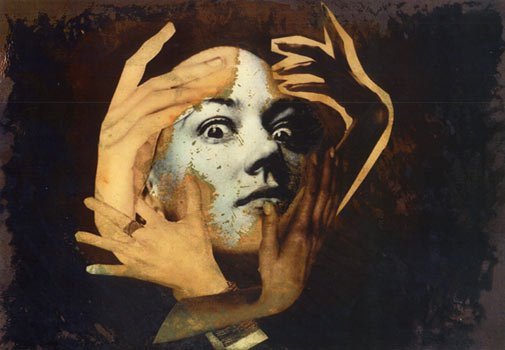Capgras Syndrome: Seeing Loved Ones as Impostors

That strange feeling is exactly what happens for people with Capgras Syndrome. They think that their loved ones have been replaced by impostors pretending to be them.
But before we dig any deeper into this topic, we have to go over a couple concepts. Two important things we want to look at are prosopagnosia and delusions and how they differ.
Prosopagnosia and delusion
All the way back in 1891, Sigmund Freud coined the term agnosia to define an inability to understand all kinds of sensory stimuli. Prosopagnosia, then, is the combination of two Greek words: “prosopon,” which means face, and “gnosis” which means recognition.
Therefore, prosopagnosia involves having trouble recognizing familiar faces. And one thing that causes it are strokes, especially in the parietal or parieto-occipital regions of the brain.
On the other hand, delusions come entirely from ideas (“delusional” ones). These are fantastical transformations of reality, false beliefs based on a mistaken interpretation of reality.
There are also five different kinds of delusional experiences. These are: delusional perception, delusional interpretation, delusional judgment, delusional fantasy, and delusional inspiration.
Now that we’ve cleared this up, we should mention that delusional misidentifcation syndromes were dismissed as just a curiosity until recently. It’s only now that they’re starting to get more attention.

Misidentification syndromes
With misidentification syndromes, what happens is that someone perceives things the right way; they just interpret them wrong. That is, what they see is real, but what they interpret isn’t.
There are four different types of delusional misidentification syndrome:
- Capgras Syndrome: the person falsely perceives that a double has replaced someone close to them (a close relative or a friend). But it’s not true.
- Fregoli Syndrome: the person will think that one or more people have changed their appearance to look more like familiar people. They think it’s so they can try to scam them.
- Intermetamorphosis: the person thinks that the people around them have swapped identities.
- Syndrome of Subjective Doubles: the person firmly believe that there are exact doubles of them out there.
Which of these delusional misidentification syndromes is the most common? It looks like it’s Capgras Syndrome: current data says it appears in 5% of all psychotic patients.
Capgras Syndrome
Capgras Syndrome was first described in 1923 by Jean Marie Capgras and J. Reboul-Lachaux. They had a 53-year-old patient with chronic psychosis and the delusional belief that her husband and son had been replaced so someone could harm her.
Like we said earlier, Capgras Syndrome is a psychiatric disorder that involves misidentifying familiar people. In other words, they think that a double, or an almost identical impostor, has replaced the real people in their life.
A person with Capgras Syndrome recognizes people but doesn’t feel like they’re familiar. They can usually somewhat recognize their spouse or child (“they look like…”), but the problem is that it’s never enough to convince them that it’s really them.
In this person’s eyes, the double, or the impostor, takes on the same physical qualities as the “original” person. But they don’t have the same mind or personality, so they’re an impostor.
Additionally, Capgras Syndrome will give them delusions that make them think the impostor is acting the same as the original person. And that only confuses them more.

What causes Capgras Syndrome?
People have linked Capgras Syndrome to a lot of different things. For example, some of these things are schizophrenia, vitamin B12 deficiency, hyperthyroidism, diabetes mellitus, intoxication, and dementia.
Many different theories have also attempted to explain it. Some have to do with a disconnection in these areas of the brain and others deal with the lateralization and localization of the dysfunction that leads to the delusion. For a person to receive a diagnosis of Capgras Syndrome, they cannot have severe dementia or any problems related to awareness.
Is there treatment?
This strange syndrome is hard to treat. People have tried using antipsychotic medications, antidepressants, and cognitive and behavioral therapy. However, while all of those have had some success, they’re still far from being a cure. Finally, when it comes to psychological therapy, therapists often try cognitive restructuring along with family therapy because of the emotional toll Capgras Syndrome takes.
Bibliography
That strange feeling is exactly what happens for people with Capgras Syndrome. They think that their loved ones have been replaced by impostors pretending to be them.
But before we dig any deeper into this topic, we have to go over a couple concepts. Two important things we want to look at are prosopagnosia and delusions and how they differ.
Prosopagnosia and delusion
All the way back in 1891, Sigmund Freud coined the term agnosia to define an inability to understand all kinds of sensory stimuli. Prosopagnosia, then, is the combination of two Greek words: “prosopon,” which means face, and “gnosis” which means recognition.
Therefore, prosopagnosia involves having trouble recognizing familiar faces. And one thing that causes it are strokes, especially in the parietal or parieto-occipital regions of the brain.
On the other hand, delusions come entirely from ideas (“delusional” ones). These are fantastical transformations of reality, false beliefs based on a mistaken interpretation of reality.
There are also five different kinds of delusional experiences. These are: delusional perception, delusional interpretation, delusional judgment, delusional fantasy, and delusional inspiration.
Now that we’ve cleared this up, we should mention that delusional misidentifcation syndromes were dismissed as just a curiosity until recently. It’s only now that they’re starting to get more attention.

Misidentification syndromes
With misidentification syndromes, what happens is that someone perceives things the right way; they just interpret them wrong. That is, what they see is real, but what they interpret isn’t.
There are four different types of delusional misidentification syndrome:
- Capgras Syndrome: the person falsely perceives that a double has replaced someone close to them (a close relative or a friend). But it’s not true.
- Fregoli Syndrome: the person will think that one or more people have changed their appearance to look more like familiar people. They think it’s so they can try to scam them.
- Intermetamorphosis: the person thinks that the people around them have swapped identities.
- Syndrome of Subjective Doubles: the person firmly believe that there are exact doubles of them out there.
Which of these delusional misidentification syndromes is the most common? It looks like it’s Capgras Syndrome: current data says it appears in 5% of all psychotic patients.
Capgras Syndrome
Capgras Syndrome was first described in 1923 by Jean Marie Capgras and J. Reboul-Lachaux. They had a 53-year-old patient with chronic psychosis and the delusional belief that her husband and son had been replaced so someone could harm her.
Like we said earlier, Capgras Syndrome is a psychiatric disorder that involves misidentifying familiar people. In other words, they think that a double, or an almost identical impostor, has replaced the real people in their life.
A person with Capgras Syndrome recognizes people but doesn’t feel like they’re familiar. They can usually somewhat recognize their spouse or child (“they look like…”), but the problem is that it’s never enough to convince them that it’s really them.
In this person’s eyes, the double, or the impostor, takes on the same physical qualities as the “original” person. But they don’t have the same mind or personality, so they’re an impostor.
Additionally, Capgras Syndrome will give them delusions that make them think the impostor is acting the same as the original person. And that only confuses them more.

What causes Capgras Syndrome?
People have linked Capgras Syndrome to a lot of different things. For example, some of these things are schizophrenia, vitamin B12 deficiency, hyperthyroidism, diabetes mellitus, intoxication, and dementia.
Many different theories have also attempted to explain it. Some have to do with a disconnection in these areas of the brain and others deal with the lateralization and localization of the dysfunction that leads to the delusion. For a person to receive a diagnosis of Capgras Syndrome, they cannot have severe dementia or any problems related to awareness.
Is there treatment?
This strange syndrome is hard to treat. People have tried using antipsychotic medications, antidepressants, and cognitive and behavioral therapy. However, while all of those have had some success, they’re still far from being a cure. Finally, when it comes to psychological therapy, therapists often try cognitive restructuring along with family therapy because of the emotional toll Capgras Syndrome takes.
Bibliography
This text is provided for informational purposes only and does not replace consultation with a professional. If in doubt, consult your specialist.







